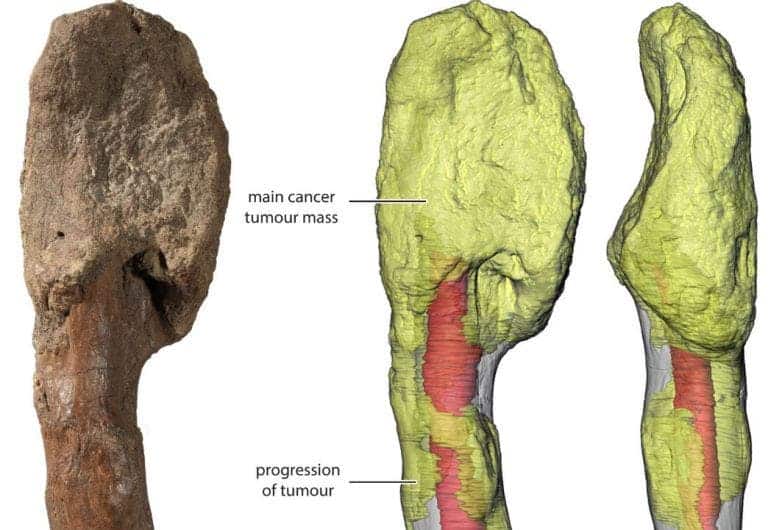Evidence is mounting that, despite living hundreds of millions of years ago, dinosaurs were not strangers to cancer.

Image credits Royal Ontario Museum / McMaster University.
Researchers have uncovered a new dinosaur fossil that seems to have suffered from a severe form of bone cancer around 77 million years ago. The findings help underscore the fact that cancer is in no ways a modern affliction — or a human-only one — and points to the role disease and other medical conditions play in the wild.
The bad bone
The research is based on the fossils of a Centrosaurus apertus, a herbivore that lived in the Canadian stretches during late Cretaceous (76 to 75 million years ago). Its life, at least during its latter parts, was probably not very enjoyable at all, as this dinosaur had to contend with a very aggressive case of bone cancer in one of its hind legs.
Not only would this make it difficult and painful for the dinosaur to move around — either to forage or to evade/fight off predators — but the team studying its fossil believes the cancer was malignant. If so, it means it could spread to its other tissues, mainly its internal organs.
The cancer in its leg bones was so advanced, that at first the team was convinced they were looking at a bone that had healed at sutured itself after a fracture. It was only after the bone was studied in depth using a host of techniques, including radiology and orthopedic surgery, that they found a massive, aggressive tumor inside the bone.
“Diagnosis of aggressive cancer like this in dinosaurs has been elusive and requires medical expertise and multiple levels of analysis to properly identify,” Dr. Mark Crowther, co-author of the study, said in a statement.
“Here, we show the unmistakable signature of advanced bone cancer in 76-million-year-old horned dinosaur—the first of its kind. It’s very exciting.”
The disease had progressed to an “advanced stage” by the time the animal died and likely made it very difficult for it to move. Still, it’s not all tragedy and woe with the dino: his remains were found in a “bone bed” along with many others from the same species. The team believes we’re looking at a pack of C. apertus that died in a flood. From the lack of bite marks on the diseased dino, and from his final resting place alongside his family and friends, it’s safe to assume that the herd lifestyle allowed it to survive despite his condition.
“The shin bone shows aggressive cancer at an advanced stage. The cancer would have had crippling effects on the individual and made it very vulnerable to the formidable tyrannosaur predators of the time,” adds Dr. David Evans, corresponding author of the study.
“The fact that this plant-eating dinosaur lived in a large, protective herd may have allowed it to survive longer than it normally would have with such a devastating disease.”
This isn’t the first time we’ve found evidence of tumors in dinosaur fossils, but it is the first confirmed case of bone cancer we’ve seen in such an animal.
The finding goes to show that even the mightiest animals sometimes have to bow in the face of disease. But it also shows how far we’ve come: dinosaurs, for all their might and long reign, were at the mercy of such conditions, and we’re starting to learn how to identify, manage, and cure them.
The paper “First case of osteosarcoma in a dinosaur: a multimodal diagnosis” has been published in the journal The Lancet.









